Study on the Aperture Evolution Law and Seepage Mechanism of 3D Rough Structure Plane under the Shear–Seepage Coupling Test
Abstract
1. Introduction
2. Experimental Methodology
2.1. Specimen Preparation
2.2. Experimental Set-Up
2.3. Test Procedure
- ♦
- 3D morphology scanning of upper and lower structural planes: before the test, the upper and lower structural planes were scanned to obtain 3D point cloud data.
- ♦
- Fix the sample: the upper and lower structure planes were placed into the upper and lower shear boxes, respectively, and then the shear box was fixed to the center of the equipment.
- ♦
- Apply normal load: a normal force was applied at a speed of 0.1 kN/s to the 3 MPa.
- ♦
- Apply water pressure: water pressure was applied to the set point until the water flow rate reached a steady value.
- ♦
- Apply shear load: a shear load was applied at a speed of 0.5 mm/min.
- ♦
- Test completion: the test ended when the shear displacement reached 10 mm, and the data were saved.
- ♦
- Three-dimensional morphology scanning of upper and lower structural planes: after completing the test, the upper and lower structural plane were scanned to obtain 3D point cloud data.
3. Test Results
3.1. Evolution of Mechanical Properties
3.2. Evolution of Mechanical Parameters
- (1)
- Peak shear stress τp: shear stress value at the maximum point of shear stress vs. shear displacement curve.
- (2)
- Peak shear displacement up: shear displacement value at the maximum point of shear stress vs. shear displacement curve.
- (3)
- Shear stiffness kn: stress gradient corresponding to shear elastic stage.
- (4)
- Peak dilatancy angle θP: maximum value of the dilatancy angles.
- (5)
- Average dilatancy angle θave: average value of dilatancy angles.
- (6)
- Peak flow rate Qp: maximum value of flow rate.
- (7)
- Initial flow rate Q0: corresponding flow rate when the shear displacement is zero.
3.3. Failure Characteristics of the Structural Plane
- (1)
- Average height z3: average height of each point on the structural plane.
- (2)
- Maximum surface elevation difference Sh: vertical distance from the highest point to the lowest point of the structural plane.
- (3)
- Maximum peak height of the surface Sp: distance from the highest point of the structural plane to the datum plane.
- (4)
- Contour area ratio SA: ratio of the developed surface area of the structural plane to the vertical projected area. The calculation is as follows:
- (5)
- Volume V: the volume of the space enclosed by the structural plane and the bottom plane.
- (6)
- Surface area St: surface developed area of the structural plane.
3.4. Evolution of Aperture
3.5. Evolution of Transmissivity
4. The Distribution of Aperture
5. Conclusions
- (1)
- When the seepage water pressure was 0 MPa, the shear stress–shear displacement curve of the structural plane was mainly of the peak type. When P ≠ 0 MPa, the shear stress–shear displacement curve of the structural plane had no softening stage, reflecting strain hardening characteristics. The normal displacement–shear displacement curves of the structural plane exhibited a trend of shear shrinkage first, followed by shear expansion. With an increase in seepage water pressure, the amount of shear expansion increased gradually. The evolution of dilatancy angle can be divided into three stages, and the evolution of discharge can be divided into two stages.
- (2)
- With an increase in seepage water pressure, the peak shear stress decreased by 13.63%, 3.036%, and 0.401%, respectively, and the peak shear displacement of the structural plane increased by 12.248%, 2.496%, and 5.406%, respectively. The shear stiffness decreased gradually by 3.884%, 3.219%, and 22.364%, respectively. The peak shear dilatancy angle and average shear dilatancy angle were both less than zero, and under other seepage water pressures, they were both greater than zero. The initial flow rate and peak flow rate increased with an increase in seepage water pressure.
- (3)
- The section line shape of the structural plane was consistent, the height decreased slightly, and the JRC of the section line decreased, indicating that the roughness of the structural plane decreased and the surface gradually became smooth. The JRC value of the contour and the 3D morphology parameters increased gradually with an increase in seepage water pressure.
- (4)
- With the increase in shear displacement, the contact area, effective aperture, and mean aperture exhibited three stages of change trend, and the transmissivity exhibited two stages of change. When the shear displacement was 0 mm, the aperture of structural plane was very small but not zero. Under the same seepage water pressure, the aperture gradually increased with the increasing shear displacement. Under the same shear displacement, with the increase of seepage water pressure, the aperture gradually increased.
Author Contributions
Funding
Data Availability Statement
Acknowledgments
Conflicts of Interest
References
- Esaki, T.; Du, S.; Mitani, Y.; Ikusada, K.; Jing, L. Development of a shear-flow test apparatus and determination of coupled properties for a single rock joint. Int. J. Rock Mech. Min. Sci. 1999, 36, 641–650. [Google Scholar] [CrossRef]
- Karimzade, E.; Seifabad, M.C.; Sharifzadeh, M.; Baghbanan, A. Modelling of Flow–Shear Coupling Process in Rough Rock Fractures Using Three-Dimensional Finite Volume Approach. Rock Mech. Rock Eng. 2019, 52, 4693–4713. [Google Scholar] [CrossRef]
- Cardinali, M.; Galli, M.; Guzzetti, F.; Ardizzone, F.; Reichenbach, P.; Bartoccini, P. Rainfall induced landslides in December 2004 in south-western Umbria, central Italy: Types, extent, damage and risk assessment. Nat. Hazards Earth Syst. Sci. 2006, 6, 237–260. [Google Scholar] [CrossRef]
- Barton, N.; Choubey, V. The shear strength of rock joints in theory and practice. Rock Mech. Rock Eng. 1977, 10, 1–54. [Google Scholar] [CrossRef]
- Barton, N. Review of a new shear-strength criterion for rock joints. Eng. Geol. 1973, 7, 287–332. [Google Scholar] [CrossRef]
- Grasselli, G. Shear Strength of Rock Joints Based on Quantified Description. Ph.D. Thesis, Swiss Federal Institute of Technology, Lausanne, Switzerland, 2001. [Google Scholar]
- Liu, X.; Zhu, W.; Yu, Q.; Chen, S.; Guan, K. Estimating the Joint Roughness Coefficient of Rock Joints from Translational Overlapping Statistical Parameters. Rock Mech. Rock Eng. 2018, 52, 753–769. [Google Scholar] [CrossRef]
- Rong, G.; Yang, J.; Cheng, L.; Zhou, C. Laboratory investigation of nonlinear flow characteristics in rough fractures during shear process. J. Hydrol. 2016, 541, 1385–1394. [Google Scholar] [CrossRef]
- Ladanyi, B.; Archambault, G. Simulation of shear behavior of jointed rock mass. In Proceedings of the 11th Symposium on Rock Mech, New York, NY, USA, 16–19 June 1969. [Google Scholar]
- Kulatilake, P.; Shou, G.; Huang, T.; Morgan, R. New peak shear strength criteria for anisotropic rock joints. Int. J. Rock Mech. Min. Sci. Géoméch. Abstr. 1995, 32, 673–697. [Google Scholar] [CrossRef]
- Zhao, J. Joint surface matching and shear strength part B: JRC-JMC shear strength criterion. Int. J. Rock Mech. Min. Sci. 1997, 34, 179–185. [Google Scholar] [CrossRef]
- Grasselli, G. Manuel Rocha Medal Recipient Shear Strength of Rock Joints Based on Quantified Surface Description. Rock Mech. Rock Eng. 2006, 39, 295–314. [Google Scholar] [CrossRef]
- Liu, Q.; Tian, Y.; Liu, D.; Jiang, Y. Updates to JRC-JCS model for estimating the peak shear strength of rock joints based on quantified surface description. Eng. Geol. 2017, 228, 282–300. [Google Scholar] [CrossRef]
- Chen, S.J.; Chang, J.P.; Ji, C.X.; Wu, X.Y.; Du, G.S.; Yang, Z.D. A two-parameter evaluation method of joint roughness and its experimental verification. Chin. J. Rock Mech. Eng. 2021, 40, 476–489. [Google Scholar] [CrossRef]
- Abolfazli, M.; Fahimifar, A. An investigation on the correlation between the joint roughness coefficient (JRC) and joint roughness parameters. Constr. Build. Mater. 2020, 259, 120415. [Google Scholar] [CrossRef]
- Yong, R.; Ye, J.; Li, B.; Du, S.-G. Determining the maximum sampling interval in rock joint roughness measurements using Fourier series. Int. J. Rock Mech. Min. Sci. 2018, 101, 78–88. [Google Scholar] [CrossRef]
- Barton, N. The shear strength of rock and rock joints. Int. J. Rock Mech. Min. Sci. Géoméch. Abstr. 1976, 13, 255–279. [Google Scholar] [CrossRef]
- Selvadurai, A.P.S.; Głowacki, A. Stress-Induced Permeability Alterations in an Argillaceous Limestone. Rock Mech. Rock Eng. 2017, 50, 1079–1096. [Google Scholar] [CrossRef]
- Yin, L. Basic Experimental Study on Water-Inrush Mechanism of Floor in Deep Mining; Shandong University of Science and Technology: Qingdao, China, 2011. [Google Scholar]
- Jiang, Y.; Xiao, J.; Tanabashi, Y.; Mizokami, T. Development of an automated servo-controlled direct shear apparatus applying a constant normal stiffness condition. Int. J. Rock Mech. Min. Sci. 2003, 41, 275–286. [Google Scholar] [CrossRef]
- Zhang, Q.; Li, X.; Bai, B.; Pei, L.; Shi, L.; Wang, Y. Development of a Direct-Shear Apparatus Coupling with High Pore Pressure and Elevated Temperatures. Rock Mech. Rock Eng. 2019, 52, 3475–3484. [Google Scholar] [CrossRef]
- Xu, J.; Liu, Y.X.; Yin, G.Z.; Li, B.; Ye, G. Development of shear-flow coupling test device for coal rock. Chin. J. Rock Mech. Eng. 2015, 34, 2987–2995. [Google Scholar] [CrossRef]
- Huang, N.; Jiang, Y.; Cheng, Y.; Liu, R. Experimental and numerical study of hydraulic properties of three-dimensional rough fracture networks based on 3d printing technology. Rock Soil Mech. 2021, 42, 1659–1668. [Google Scholar] [CrossRef]
- Mofakham, A.A.; Stadelman, M.; Ahmadi, G.; Shanley, K.T.; Crandall, D. Computational Modeling of Hydraulic Properties of a Sheared Single Rock Fracture. Transp. Porous Media 2018, 124, 1–30. [Google Scholar] [CrossRef]
- Chen, Y.; Liang, W.; Lian, H.; Yang, J.; Nguyen, V.P. Experimental study on the effect of fracture geometric characteristics on the effect of fracture geometric characteristics on the permaeability in deformable rough-walled fracture. Int. J. Rock Mech. Min. Sci. 2017, 98, 121–140. [Google Scholar] [CrossRef]
- Yin, Q.; Ma, G.; Jing, H.; Wang, H.; Su, H.; Wang, Y.; Liu, R. Hydraulic properties of 3D rough-walled fractures during shearing: An experimental study. J. Hydrol. 2017, 555, 169–184. [Google Scholar] [CrossRef]
- Gentier, S.; Lamontagne, E.; Archambault, G.; Riss, J. Anisotropy of flow in a fracture undergoing shear and its relationship to the direction of shearing and injection pressure. Int. J. Rock Mech. Min. Sci. 1997, 34, 94.e1–94.e12. [Google Scholar] [CrossRef]
- Tsang, Y.W.; Witherspoon, P.A. The dependence of fracture mechanical and fluid flow properties on fracture roughness and sample size. J. Geophys. Res. Atmos. 1983, 88, 2359. [Google Scholar] [CrossRef]
- Saeb, S.; Amadei, B. Modelling rock joints under shear and normal loading. Int. J. Rock Mech. Min. Sci. Géoméch. Abstr. 1992, 29, 267–278. [Google Scholar] [CrossRef]
- Koyama, T.; Li, B.; Jiang, Y.; Jing, L. Coupled shear-flow tests for rock fractures with visualization of the fluid flow and their numerical simulations. Int. J. Geotech. Eng. 2008, 2, 215–227. [Google Scholar] [CrossRef]
- Brown, S.R. Fluid flow through rock joints: The effect of surface roughness. J. Geophys. Res. Atmos. 1987, 92, 1337–1347. [Google Scholar] [CrossRef]
- Lee, H.S.; Cho, T.F. Hydraulic Characteristics of Rough Fractures in Linear Flow under Normal and Shear Load. Rock Mech. Rock Eng. 2002, 35, 299–318. [Google Scholar] [CrossRef]
- Jiang, Y.; Tanabashi, Y.; Xiao, J.; Nagaie, K. An improved shear-flow test apparatus and its application to deep underground construction. Int. J. Rock Mech. Min. Sci. 2004, 41, 170–175. [Google Scholar] [CrossRef]
- Zhang, Z.; Nemcik, J. Fluid flow regimes and nonlinear flow characteristics in deformable rock fractures. J. Hydrol. 2013, 477, 139–151. [Google Scholar] [CrossRef]
- Chen, Y.-F.; Zhou, J.-Q.; Hu, S.-H.; Hu, R.; Zhou, C.-B. Evaluation of Forchheimer equation coefficients for non-Darcy flow in deformable rough-walled fractures. J. Hydrol. 2015, 529, 993–1006. [Google Scholar] [CrossRef]
- Olsson, R.; Barton, N. An improved model for hydromechanical coupling during shearing of rock joints. Int. J. Rock Mech. Min. Sci. 2001, 38, 317–329. [Google Scholar] [CrossRef]
- Li, B.; Jiang, Y.; Koyama, T.; Jing, L.; Tanabashi, Y. Experimental study of the hydro-mechanical hehavior of rock joints using a parallel-plate model containing contact areas and artifical fractures. Int. J. Rock Mech. Min. Sci. 2008, 45, 362–375. [Google Scholar] [CrossRef]
- Chen, Y.; Lian, H.; Liang, W.; Yang, J.; Nguyen, V.P.; Bordas, S.P. The influence of fracture geometry variation on non-Darcy flow in fractures under confining stresses. Int. J. Rock Mech. Min. Sci. 2018, 113, 59–71. [Google Scholar] [CrossRef]
- Barker, J.A. A generalized radial flow model for hydraulic tests in fractured rock. Water Resour. Res. 1988, 24, 1796–1804. [Google Scholar] [CrossRef]
- Cao, C.; Xu, Z.; Chai, J.; Li, Y. Radial fluid flow regime in a single fracture under high hydraulic pressure during shear process. J. Hydrol. 2019, 579, 124142. [Google Scholar] [CrossRef]
- Ding, L.N.; Chai, J.R.; Qin, Y.; Xu, Z.G. Derivation and experimental study of the cubic law of radial flow. J. Water Resour. Water Eng. 2019, 30, 242–247. [Google Scholar] [CrossRef]
- Li, W.; Wang, Z.C.; Bi, L.P.; Liu, J. Representative elementary volume size for permeable property and equivalent permeability of fractured rock mass in radial flow configuration. Rock Soil Mech. 2019, 40, 720–727. [Google Scholar] [CrossRef]
- Cao, C.; Chai, J.; Qin, Y.; Xu, Z.G.; Tan, R. Hydraulic behavior and deformation in single fracture with asperities crushed during shear. J. Northwest A&F Univ. 2018, 46, 139–147. [Google Scholar] [CrossRef]
- Liu, Y.X. Mechanism of Structure Degradation and permeability of Rock Mass Induced by Fluid Injection under Compression-shear Loads. Ph.D. Thesis, Chongqing University, Chongqing, China, 2018. [Google Scholar]
- Muralha, J.; Grasselli, G.; Tatone, B.; Blümel, M.; Chryssanthakis, P.; Yujing, J. ISRM suggested method for laboratory determination of the shear strength of rock joints: Revised version. Rock Mech. Rock Eng. 2014, 47, 291–302. [Google Scholar] [CrossRef]
- Yang, Z.-Y.; Lo, S.C.; Di, C.C. Reassessing the Joint Roughness Coefficient (JRC) Estimation Using Z 2. Rock Mech. Rock Eng. 2001, 34, 243–251. [Google Scholar] [CrossRef]
- Olsson, W.; Brown, S. Hydromechanical response of a fracture undergoing compression and shear. Int. J. Rock Mech. Min. Sci. Géoméch. Abstr. 1993, 30, 845–851. [Google Scholar] [CrossRef]
- Liu, S.; Li, X. Experimental study on the effect of cold soaking with liquid nitrogen on the coal chemical and microstructural characteristics. Environ. Sci. Pollut. Res. 2022. [Google Scholar] [CrossRef] [PubMed]
- Liu, S.; Sun, H.; Zhang, D.; Yang, K.; Wang, D.; Li, X.; Long, K.; Li, Y. Nuclear magnetic resonance study on the influence of liquid nitrogen cold soaking on the pore structure of different coals. Phys. Fluids 2023, 35, 012009. [Google Scholar] [CrossRef]

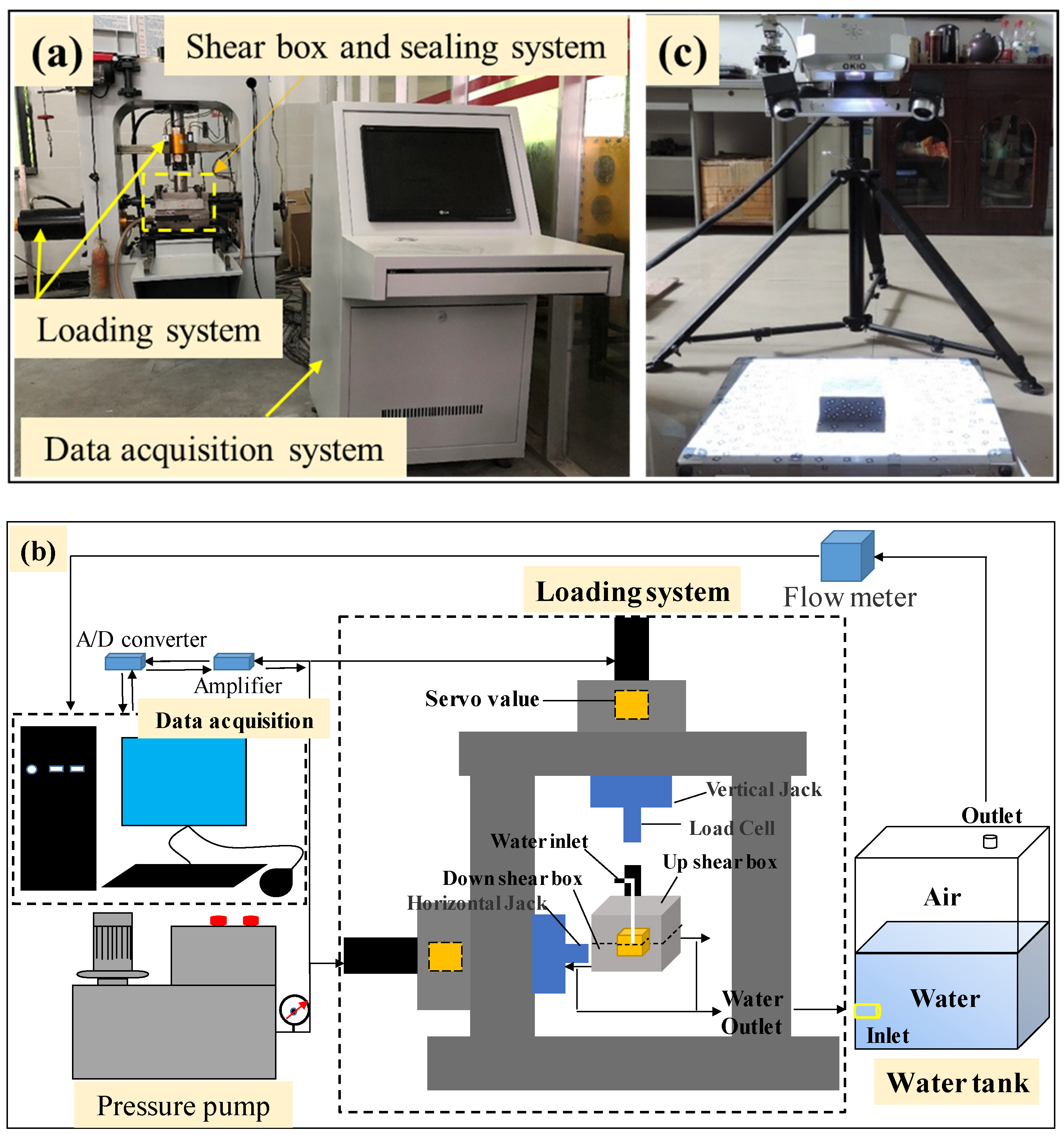
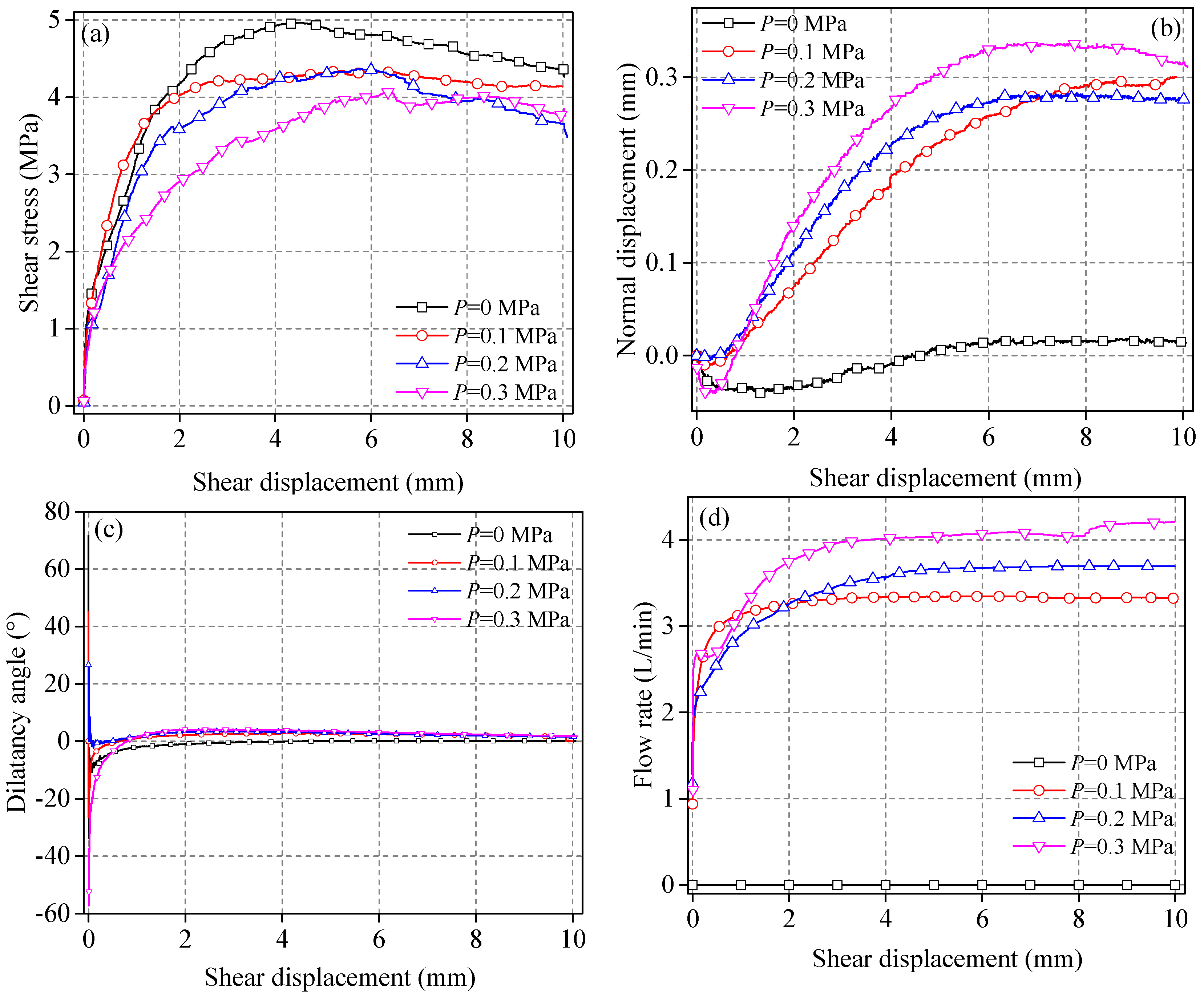

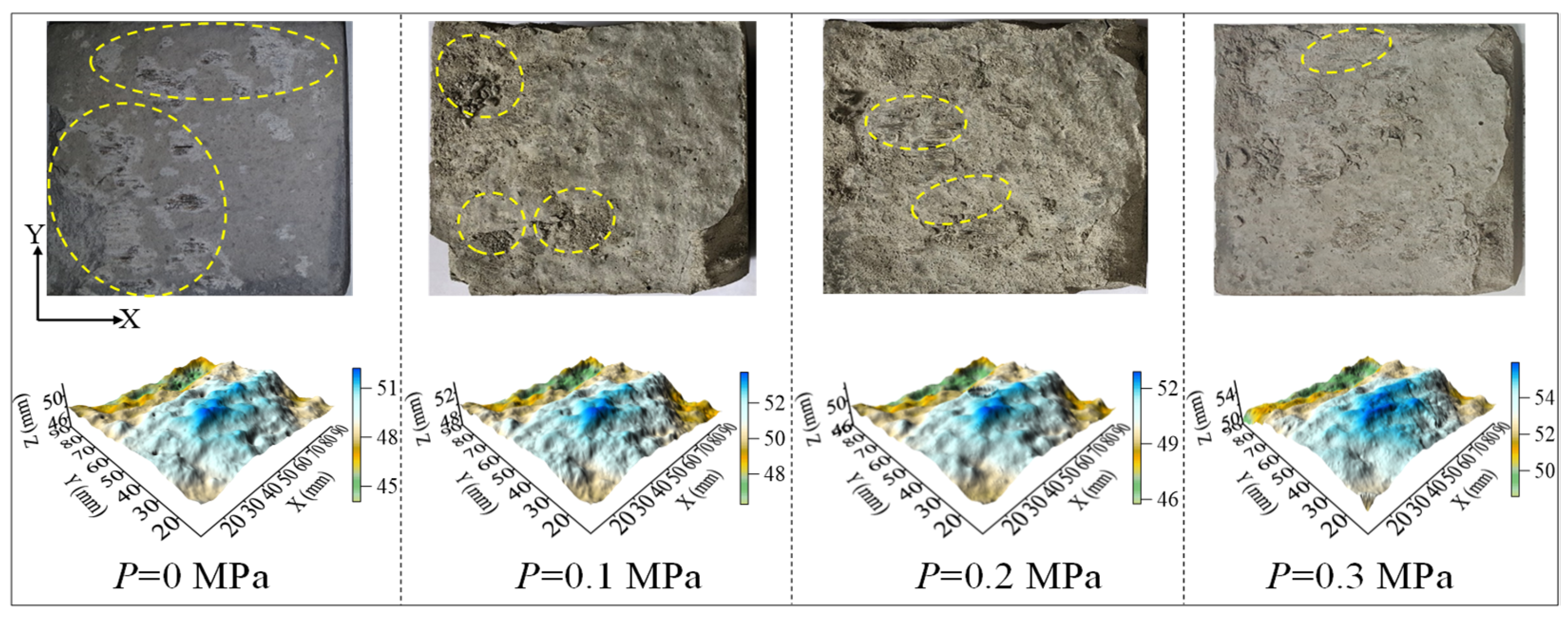
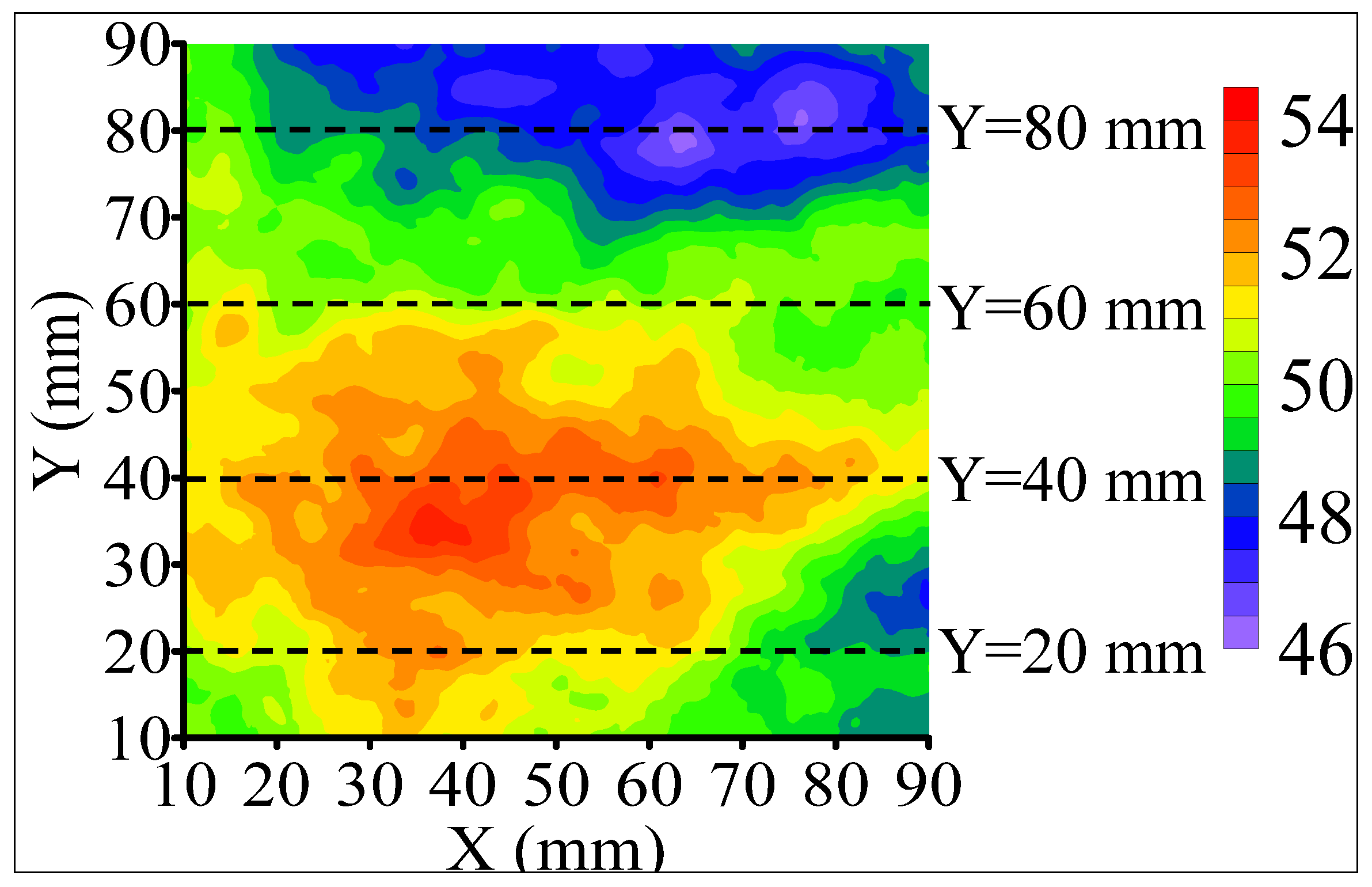
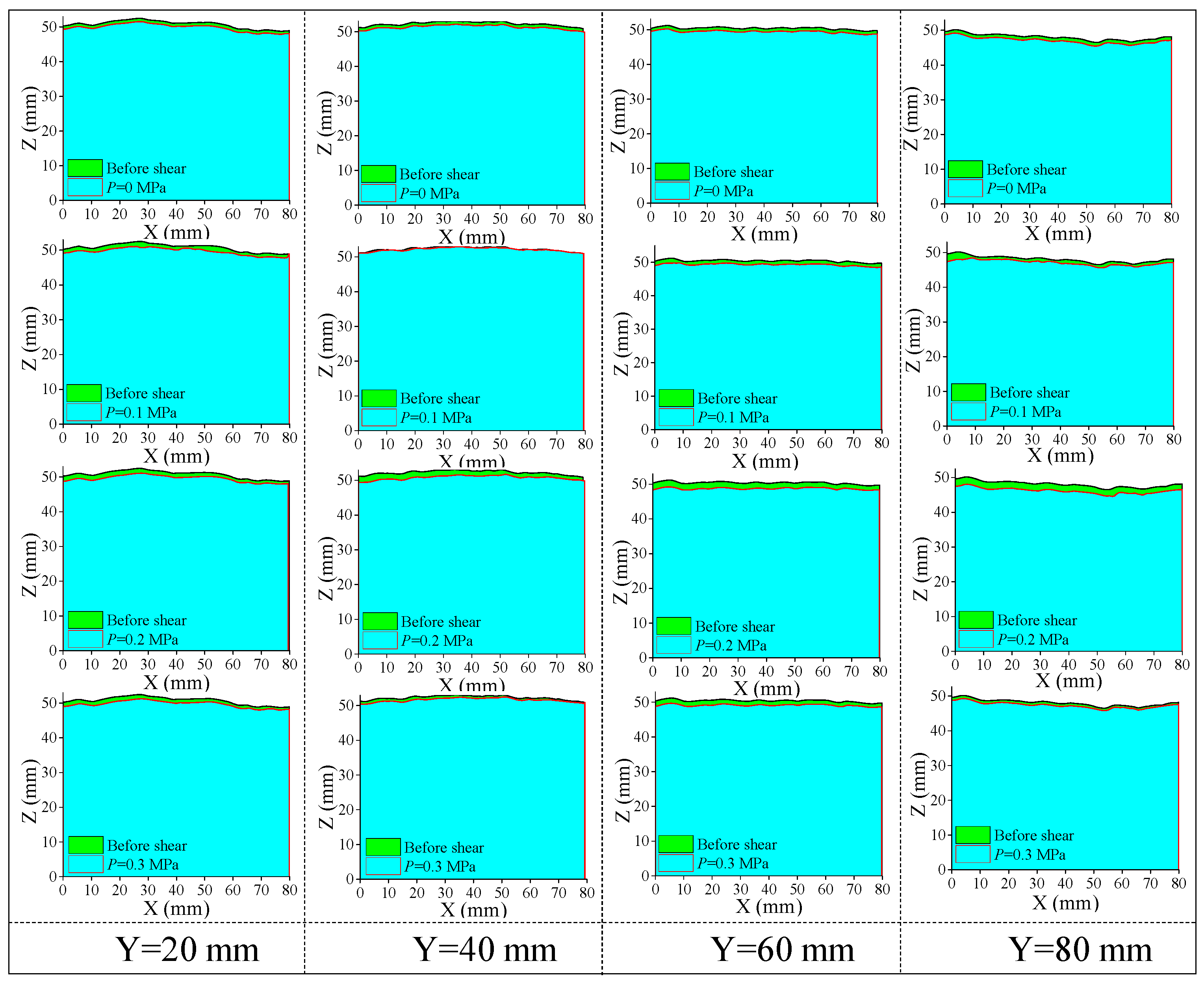
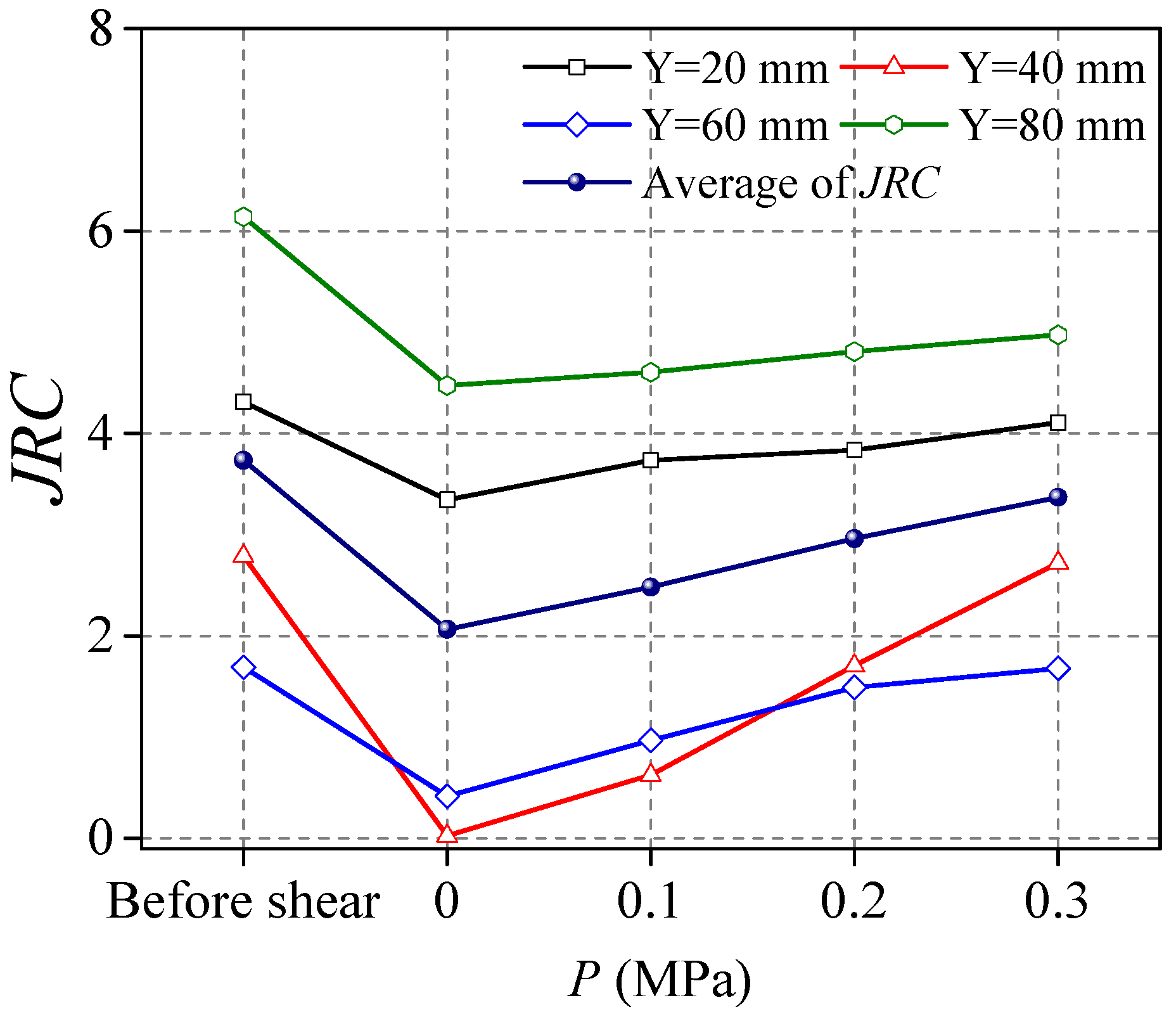
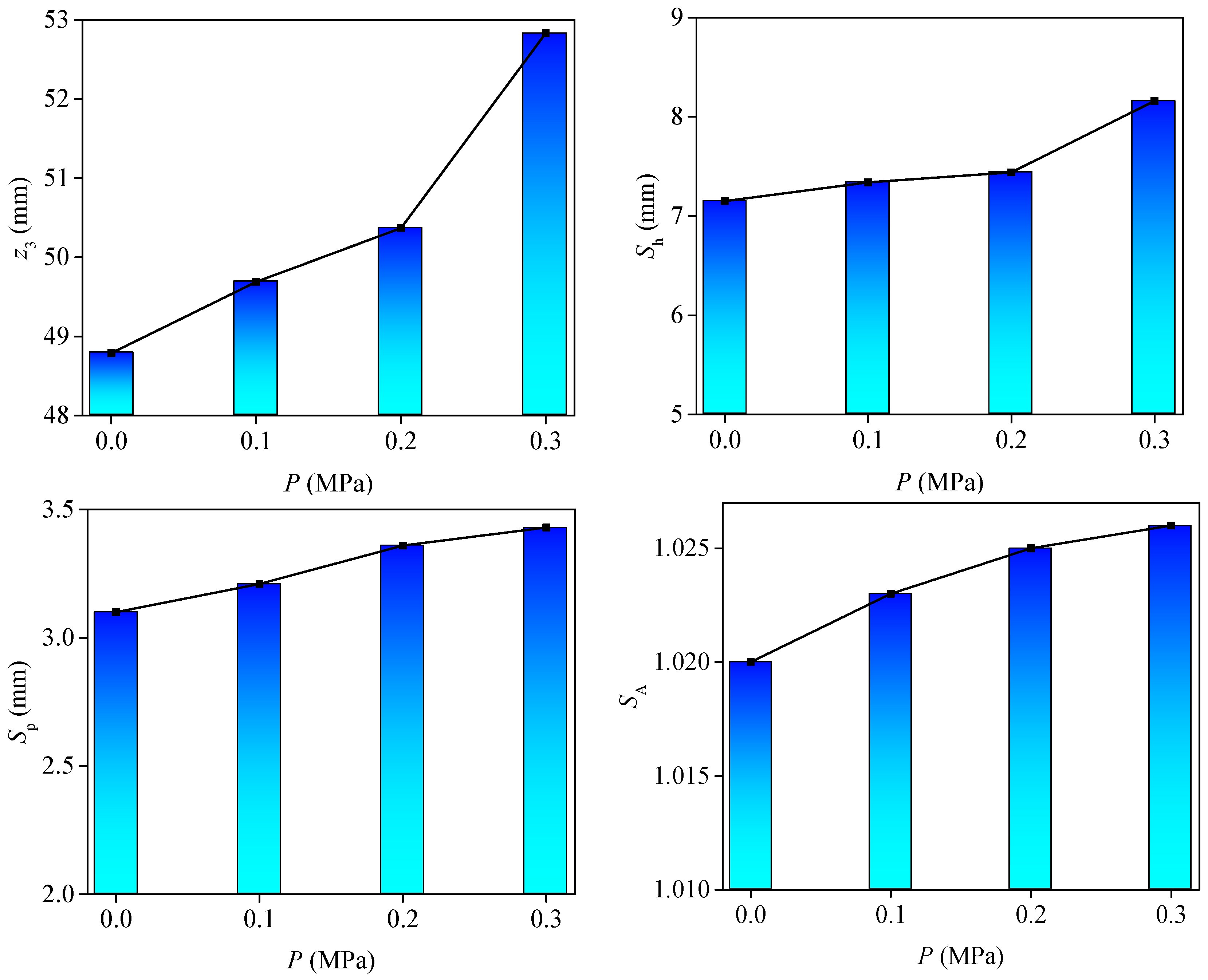

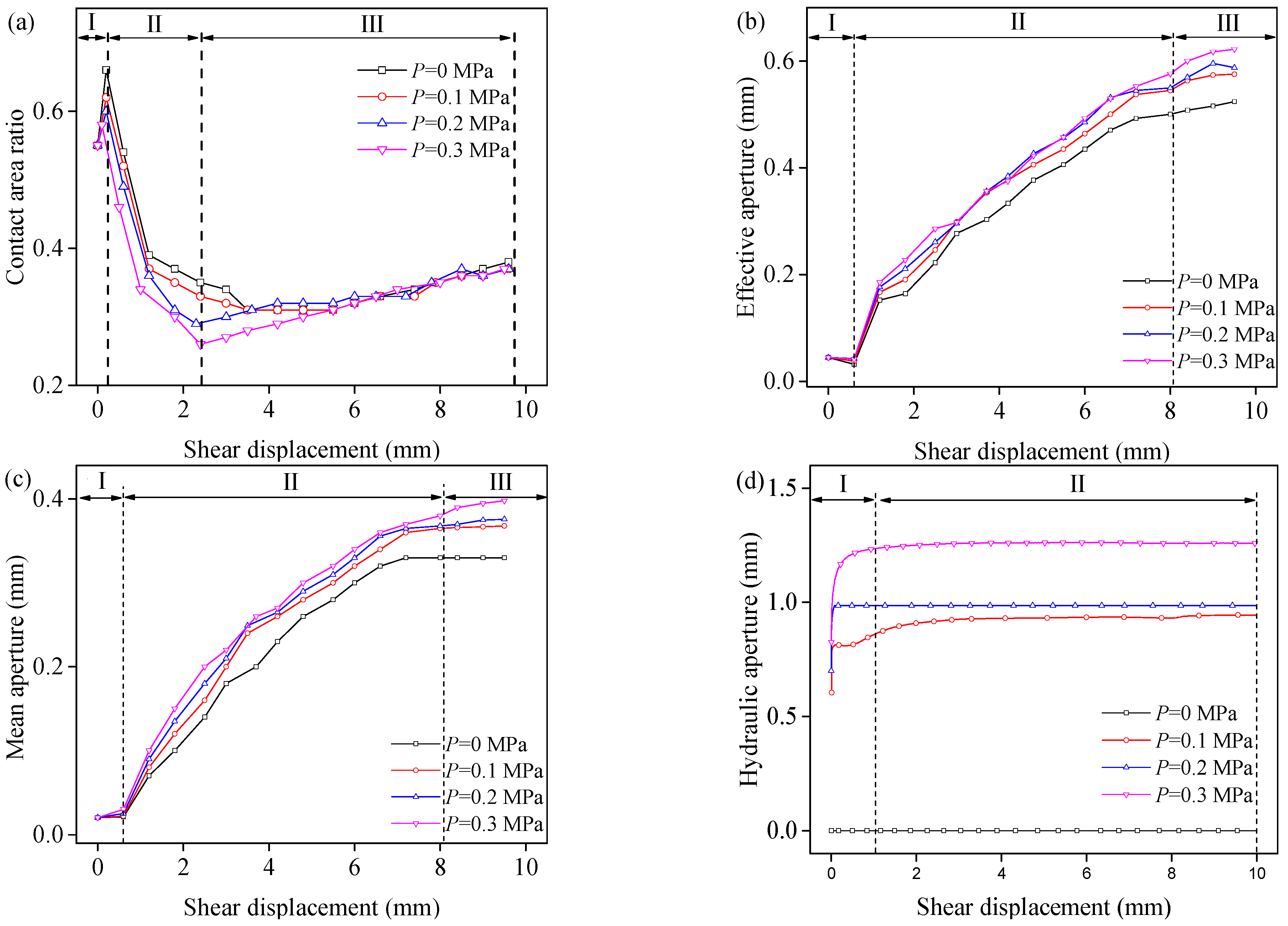



| Mechanical Parameters | ρ (g·cm−3) | σc (MPa) | c (MPa) | φb (°) | E (GPa) | ν |
|---|---|---|---|---|---|---|
| Sandstone | 2.32 | 81.04 | 11.52 | 67.18 | 6.79 | 0.26 |
| Similar material | 2.05 | 77.57 | 14.37 | 62.39 | 6.35 | 0.24 |
Disclaimer/Publisher’s Note: The statements, opinions and data contained in all publications are solely those of the individual author(s) and contributor(s) and not of MDPI and/or the editor(s). MDPI and/or the editor(s) disclaim responsibility for any injury to people or property resulting from any ideas, methods, instructions or products referred to in the content. |
© 2023 by the authors. Licensee MDPI, Basel, Switzerland. This article is an open access article distributed under the terms and conditions of the Creative Commons Attribution (CC BY) license (https://creativecommons.org/licenses/by/4.0/).
Share and Cite
Jiao, F.; Xu, J.; Peng, S.; He, M.; Zhang, X. Study on the Aperture Evolution Law and Seepage Mechanism of 3D Rough Structure Plane under the Shear–Seepage Coupling Test. Energies 2023, 16, 2133. https://doi.org/10.3390/en16052133
Jiao F, Xu J, Peng S, He M, Zhang X. Study on the Aperture Evolution Law and Seepage Mechanism of 3D Rough Structure Plane under the Shear–Seepage Coupling Test. Energies. 2023; 16(5):2133. https://doi.org/10.3390/en16052133
Chicago/Turabian StyleJiao, Feng, Jiang Xu, Shoujian Peng, Meixin He, and Xinrui Zhang. 2023. "Study on the Aperture Evolution Law and Seepage Mechanism of 3D Rough Structure Plane under the Shear–Seepage Coupling Test" Energies 16, no. 5: 2133. https://doi.org/10.3390/en16052133
APA StyleJiao, F., Xu, J., Peng, S., He, M., & Zhang, X. (2023). Study on the Aperture Evolution Law and Seepage Mechanism of 3D Rough Structure Plane under the Shear–Seepage Coupling Test. Energies, 16(5), 2133. https://doi.org/10.3390/en16052133







